Parliamentary System of Italy
VerifiedAdded on 2023/04/19
|9
|2117
|473
AI Summary
This article provides an overview of the parliamentary system in Italy, including the structure and functions of the two houses of parliament, the Senate of the Republic and the Chamber of Deputies. It also discusses the sources of law in Italy, the court structure, and the strength of the rule of law in the country.
Contribute Materials
Your contribution can guide someone’s learning journey. Share your
documents today.
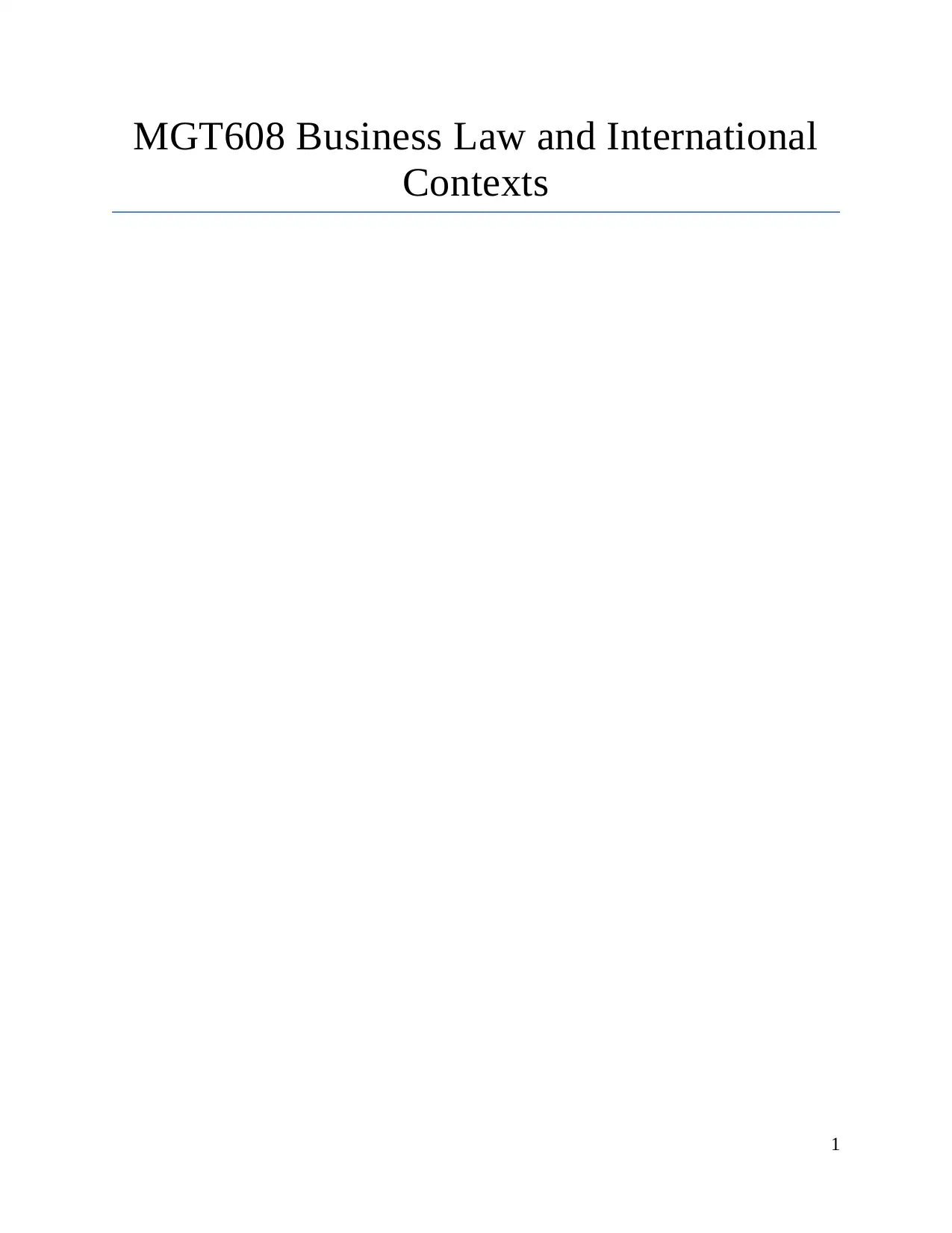
MGT608 Business Law and International
Contexts
1
Contexts
1
Secure Best Marks with AI Grader
Need help grading? Try our AI Grader for instant feedback on your assignments.
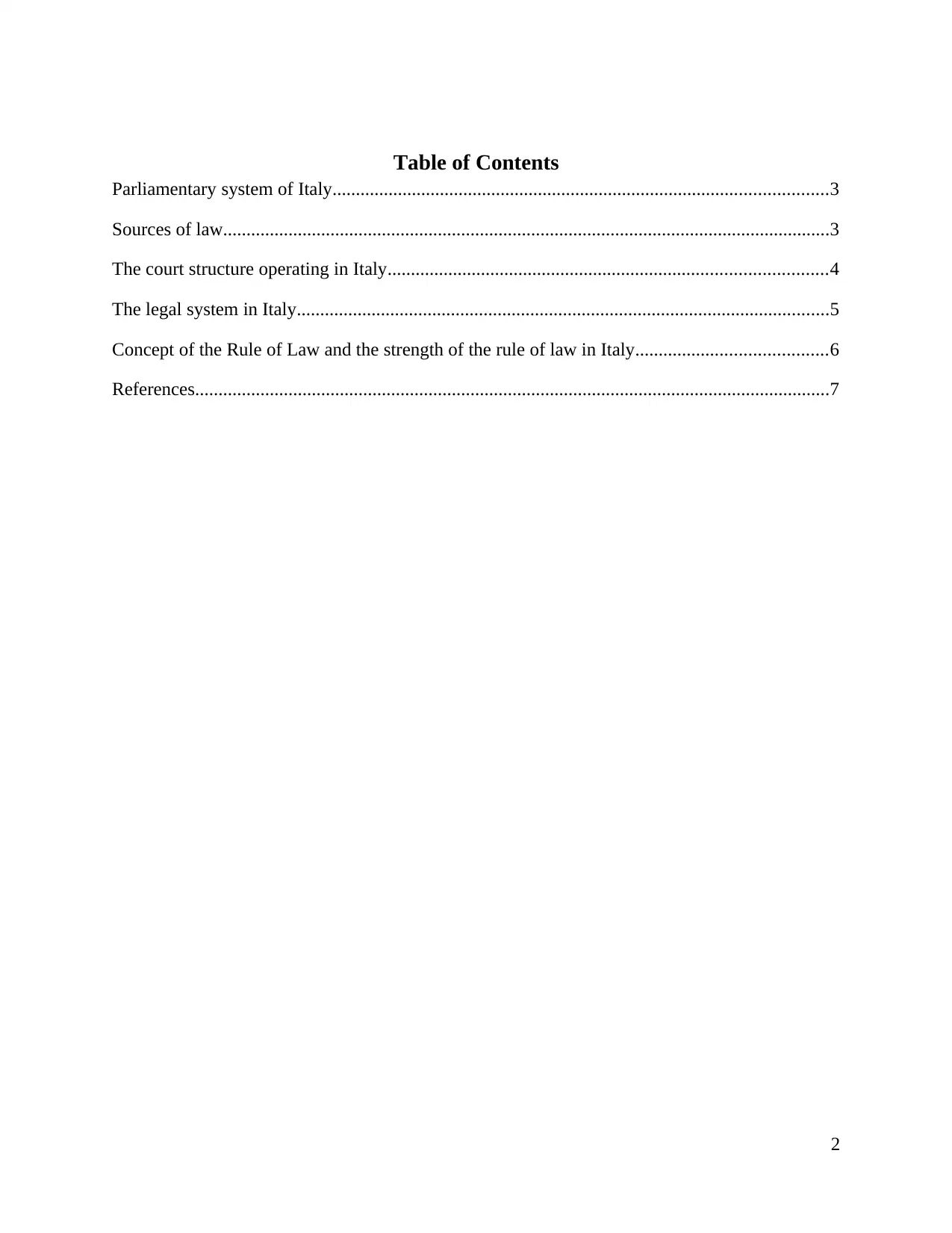
Table of Contents
Parliamentary system of Italy..........................................................................................................3
Sources of law..................................................................................................................................3
The court structure operating in Italy..............................................................................................4
The legal system in Italy..................................................................................................................5
Concept of the Rule of Law and the strength of the rule of law in Italy.........................................6
References........................................................................................................................................7
2
Parliamentary system of Italy..........................................................................................................3
Sources of law..................................................................................................................................3
The court structure operating in Italy..............................................................................................4
The legal system in Italy..................................................................................................................5
Concept of the Rule of Law and the strength of the rule of law in Italy.........................................6
References........................................................................................................................................7
2
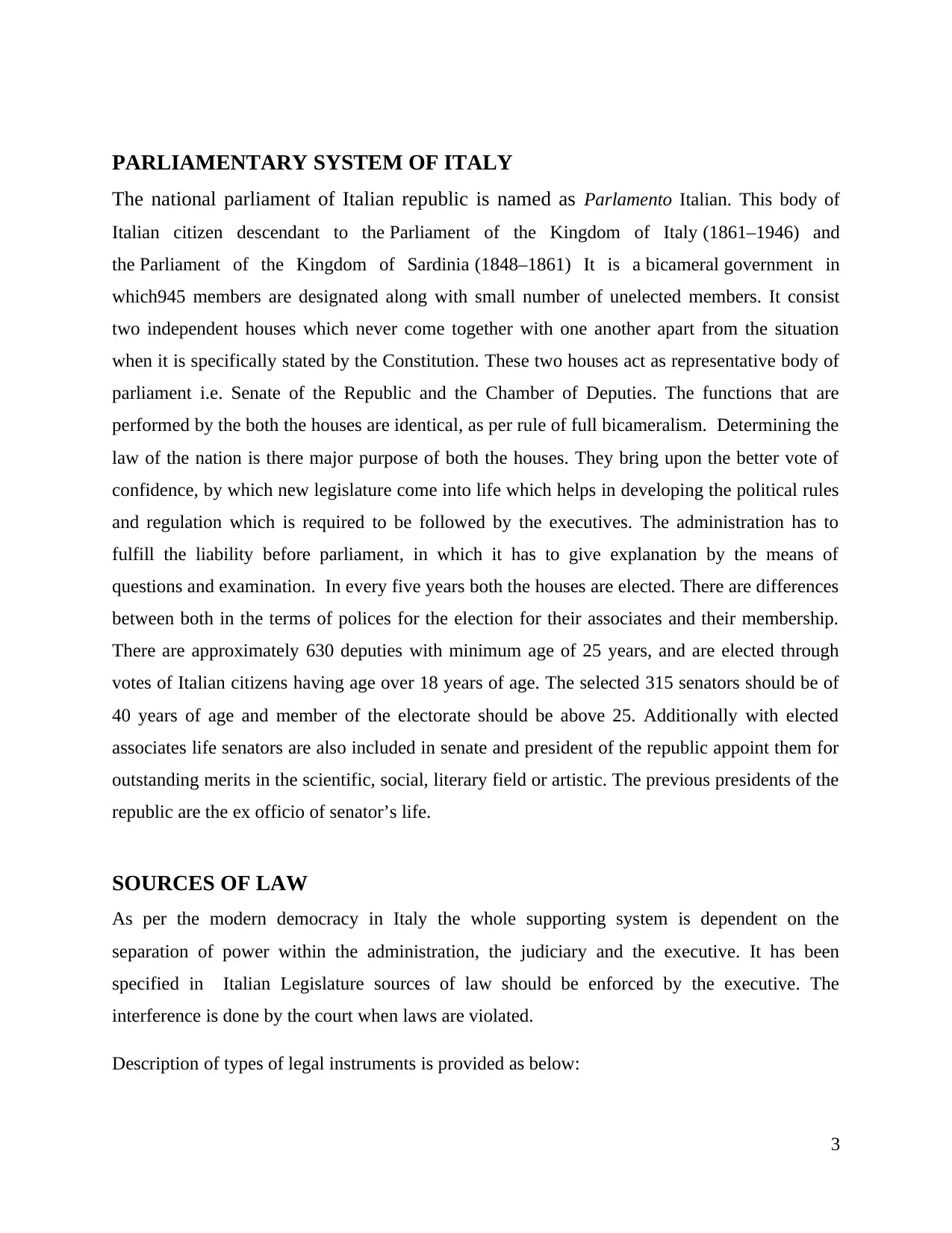
PARLIAMENTARY SYSTEM OF ITALY
The national parliament of Italian republic is named as Parlamento Italian. This body of
Italian citizen descendant to the Parliament of the Kingdom of Italy (1861–1946) and
the Parliament of the Kingdom of Sardinia (1848–1861) It is a bicameral government in
which945 members are designated along with small number of unelected members. It consist
two independent houses which never come together with one another apart from the situation
when it is specifically stated by the Constitution. These two houses act as representative body of
parliament i.e. Senate of the Republic and the Chamber of Deputies. The functions that are
performed by the both the houses are identical, as per rule of full bicameralism. Determining the
law of the nation is there major purpose of both the houses. They bring upon the better vote of
confidence, by which new legislature come into life which helps in developing the political rules
and regulation which is required to be followed by the executives. The administration has to
fulfill the liability before parliament, in which it has to give explanation by the means of
questions and examination. In every five years both the houses are elected. There are differences
between both in the terms of polices for the election for their associates and their membership.
There are approximately 630 deputies with minimum age of 25 years, and are elected through
votes of Italian citizens having age over 18 years of age. The selected 315 senators should be of
40 years of age and member of the electorate should be above 25. Additionally with elected
associates life senators are also included in senate and president of the republic appoint them for
outstanding merits in the scientific, social, literary field or artistic. The previous presidents of the
republic are the ex officio of senator’s life.
SOURCES OF LAW
As per the modern democracy in Italy the whole supporting system is dependent on the
separation of power within the administration, the judiciary and the executive. It has been
specified in Italian Legislature sources of law should be enforced by the executive. The
interference is done by the court when laws are violated.
Description of types of legal instruments is provided as below:
3
The national parliament of Italian republic is named as Parlamento Italian. This body of
Italian citizen descendant to the Parliament of the Kingdom of Italy (1861–1946) and
the Parliament of the Kingdom of Sardinia (1848–1861) It is a bicameral government in
which945 members are designated along with small number of unelected members. It consist
two independent houses which never come together with one another apart from the situation
when it is specifically stated by the Constitution. These two houses act as representative body of
parliament i.e. Senate of the Republic and the Chamber of Deputies. The functions that are
performed by the both the houses are identical, as per rule of full bicameralism. Determining the
law of the nation is there major purpose of both the houses. They bring upon the better vote of
confidence, by which new legislature come into life which helps in developing the political rules
and regulation which is required to be followed by the executives. The administration has to
fulfill the liability before parliament, in which it has to give explanation by the means of
questions and examination. In every five years both the houses are elected. There are differences
between both in the terms of polices for the election for their associates and their membership.
There are approximately 630 deputies with minimum age of 25 years, and are elected through
votes of Italian citizens having age over 18 years of age. The selected 315 senators should be of
40 years of age and member of the electorate should be above 25. Additionally with elected
associates life senators are also included in senate and president of the republic appoint them for
outstanding merits in the scientific, social, literary field or artistic. The previous presidents of the
republic are the ex officio of senator’s life.
SOURCES OF LAW
As per the modern democracy in Italy the whole supporting system is dependent on the
separation of power within the administration, the judiciary and the executive. It has been
specified in Italian Legislature sources of law should be enforced by the executive. The
interference is done by the court when laws are violated.
Description of types of legal instruments is provided as below:
3
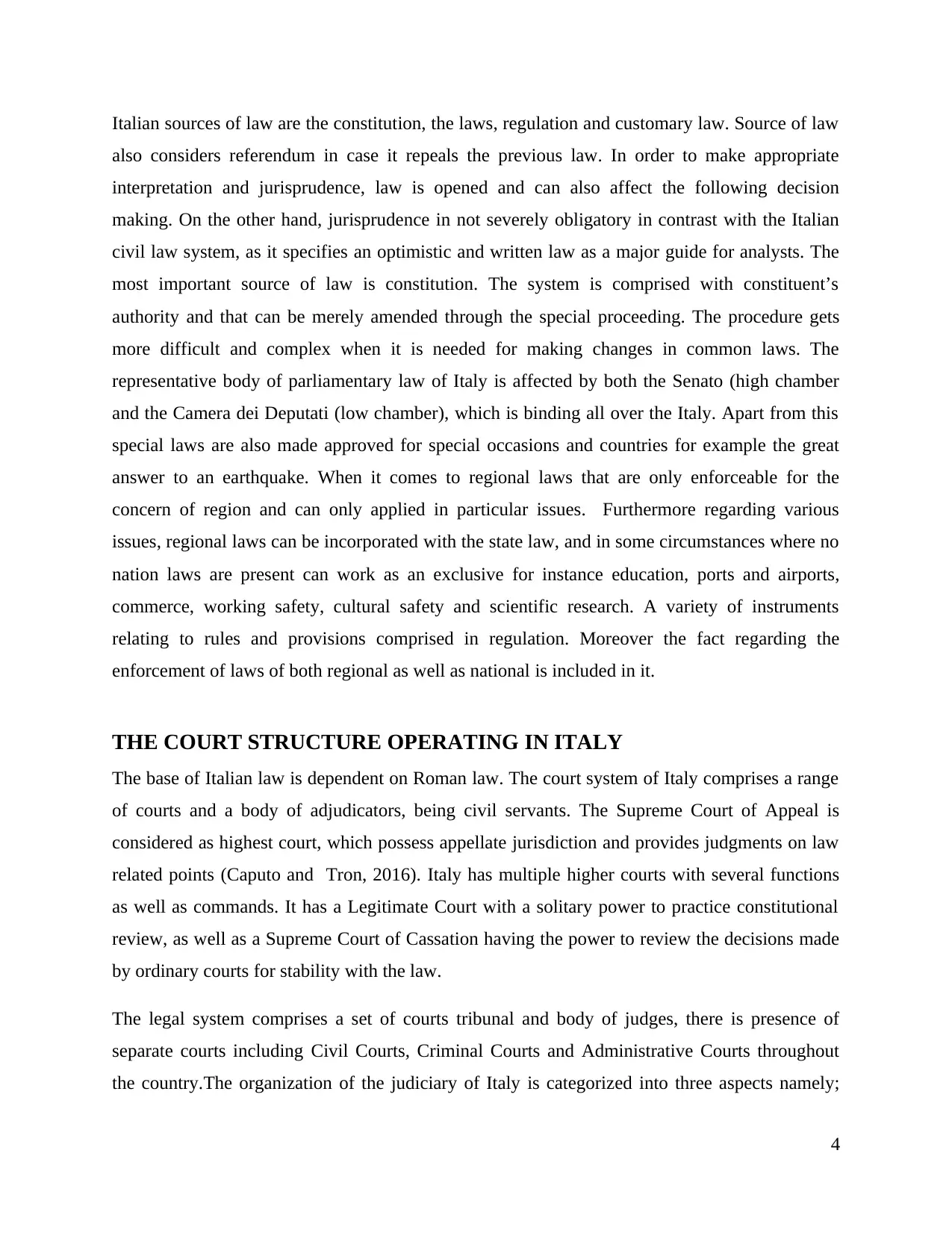
Italian sources of law are the constitution, the laws, regulation and customary law. Source of law
also considers referendum in case it repeals the previous law. In order to make appropriate
interpretation and jurisprudence, law is opened and can also affect the following decision
making. On the other hand, jurisprudence in not severely obligatory in contrast with the Italian
civil law system, as it specifies an optimistic and written law as a major guide for analysts. The
most important source of law is constitution. The system is comprised with constituent’s
authority and that can be merely amended through the special proceeding. The procedure gets
more difficult and complex when it is needed for making changes in common laws. The
representative body of parliamentary law of Italy is affected by both the Senato (high chamber
and the Camera dei Deputati (low chamber), which is binding all over the Italy. Apart from this
special laws are also made approved for special occasions and countries for example the great
answer to an earthquake. When it comes to regional laws that are only enforceable for the
concern of region and can only applied in particular issues. Furthermore regarding various
issues, regional laws can be incorporated with the state law, and in some circumstances where no
nation laws are present can work as an exclusive for instance education, ports and airports,
commerce, working safety, cultural safety and scientific research. A variety of instruments
relating to rules and provisions comprised in regulation. Moreover the fact regarding the
enforcement of laws of both regional as well as national is included in it.
THE COURT STRUCTURE OPERATING IN ITALY
The base of Italian law is dependent on Roman law. The court system of Italy comprises a range
of courts and a body of adjudicators, being civil servants. The Supreme Court of Appeal is
considered as highest court, which possess appellate jurisdiction and provides judgments on law
related points (Caputo and Tron, 2016). Italy has multiple higher courts with several functions
as well as commands. It has a Legitimate Court with a solitary power to practice constitutional
review, as well as a Supreme Court of Cassation having the power to review the decisions made
by ordinary courts for stability with the law.
The legal system comprises a set of courts tribunal and body of judges, there is presence of
separate courts including Civil Courts, Criminal Courts and Administrative Courts throughout
the country.The organization of the judiciary of Italy is categorized into three aspects namely;
4
also considers referendum in case it repeals the previous law. In order to make appropriate
interpretation and jurisprudence, law is opened and can also affect the following decision
making. On the other hand, jurisprudence in not severely obligatory in contrast with the Italian
civil law system, as it specifies an optimistic and written law as a major guide for analysts. The
most important source of law is constitution. The system is comprised with constituent’s
authority and that can be merely amended through the special proceeding. The procedure gets
more difficult and complex when it is needed for making changes in common laws. The
representative body of parliamentary law of Italy is affected by both the Senato (high chamber
and the Camera dei Deputati (low chamber), which is binding all over the Italy. Apart from this
special laws are also made approved for special occasions and countries for example the great
answer to an earthquake. When it comes to regional laws that are only enforceable for the
concern of region and can only applied in particular issues. Furthermore regarding various
issues, regional laws can be incorporated with the state law, and in some circumstances where no
nation laws are present can work as an exclusive for instance education, ports and airports,
commerce, working safety, cultural safety and scientific research. A variety of instruments
relating to rules and provisions comprised in regulation. Moreover the fact regarding the
enforcement of laws of both regional as well as national is included in it.
THE COURT STRUCTURE OPERATING IN ITALY
The base of Italian law is dependent on Roman law. The court system of Italy comprises a range
of courts and a body of adjudicators, being civil servants. The Supreme Court of Appeal is
considered as highest court, which possess appellate jurisdiction and provides judgments on law
related points (Caputo and Tron, 2016). Italy has multiple higher courts with several functions
as well as commands. It has a Legitimate Court with a solitary power to practice constitutional
review, as well as a Supreme Court of Cassation having the power to review the decisions made
by ordinary courts for stability with the law.
The legal system comprises a set of courts tribunal and body of judges, there is presence of
separate courts including Civil Courts, Criminal Courts and Administrative Courts throughout
the country.The organization of the judiciary of Italy is categorized into three aspects namely;
4
Secure Best Marks with AI Grader
Need help grading? Try our AI Grader for instant feedback on your assignments.
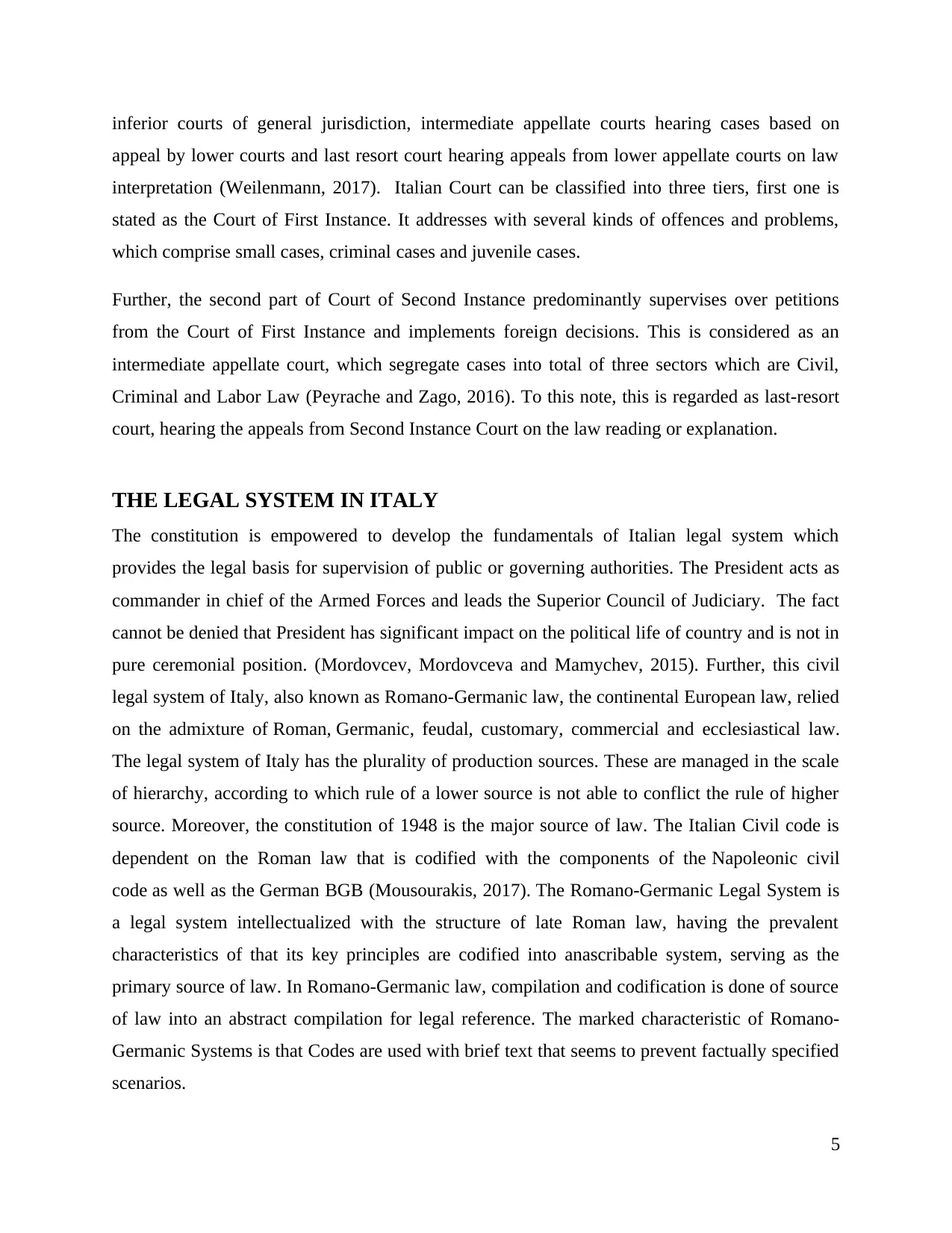
inferior courts of general jurisdiction, intermediate appellate courts hearing cases based on
appeal by lower courts and last resort court hearing appeals from lower appellate courts on law
interpretation (Weilenmann, 2017). Italian Court can be classified into three tiers, first one is
stated as the Court of First Instance. It addresses with several kinds of offences and problems,
which comprise small cases, criminal cases and juvenile cases.
Further, the second part of Court of Second Instance predominantly supervises over petitions
from the Court of First Instance and implements foreign decisions. This is considered as an
intermediate appellate court, which segregate cases into total of three sectors which are Civil,
Criminal and Labor Law (Peyrache and Zago, 2016). To this note, this is regarded as last-resort
court, hearing the appeals from Second Instance Court on the law reading or explanation.
THE LEGAL SYSTEM IN ITALY
The constitution is empowered to develop the fundamentals of Italian legal system which
provides the legal basis for supervision of public or governing authorities. The President acts as
commander in chief of the Armed Forces and leads the Superior Council of Judiciary. The fact
cannot be denied that President has significant impact on the political life of country and is not in
pure ceremonial position. (Mordovcev, Mordovceva and Mamychev, 2015). Further, this civil
legal system of Italy, also known as Romano-Germanic law, the continental European law, relied
on the admixture of Roman, Germanic, feudal, customary, commercial and ecclesiastical law.
The legal system of Italy has the plurality of production sources. These are managed in the scale
of hierarchy, according to which rule of a lower source is not able to conflict the rule of higher
source. Moreover, the constitution of 1948 is the major source of law. The Italian Civil code is
dependent on the Roman law that is codified with the components of the Napoleonic civil
code as well as the German BGB (Mousourakis, 2017). The Romano-Germanic Legal System is
a legal system intellectualized with the structure of late Roman law, having the prevalent
characteristics of that its key principles are codified into anascribable system, serving as the
primary source of law. In Romano-Germanic law, compilation and codification is done of source
of law into an abstract compilation for legal reference. The marked characteristic of Romano-
Germanic Systems is that Codes are used with brief text that seems to prevent factually specified
scenarios.
5
appeal by lower courts and last resort court hearing appeals from lower appellate courts on law
interpretation (Weilenmann, 2017). Italian Court can be classified into three tiers, first one is
stated as the Court of First Instance. It addresses with several kinds of offences and problems,
which comprise small cases, criminal cases and juvenile cases.
Further, the second part of Court of Second Instance predominantly supervises over petitions
from the Court of First Instance and implements foreign decisions. This is considered as an
intermediate appellate court, which segregate cases into total of three sectors which are Civil,
Criminal and Labor Law (Peyrache and Zago, 2016). To this note, this is regarded as last-resort
court, hearing the appeals from Second Instance Court on the law reading or explanation.
THE LEGAL SYSTEM IN ITALY
The constitution is empowered to develop the fundamentals of Italian legal system which
provides the legal basis for supervision of public or governing authorities. The President acts as
commander in chief of the Armed Forces and leads the Superior Council of Judiciary. The fact
cannot be denied that President has significant impact on the political life of country and is not in
pure ceremonial position. (Mordovcev, Mordovceva and Mamychev, 2015). Further, this civil
legal system of Italy, also known as Romano-Germanic law, the continental European law, relied
on the admixture of Roman, Germanic, feudal, customary, commercial and ecclesiastical law.
The legal system of Italy has the plurality of production sources. These are managed in the scale
of hierarchy, according to which rule of a lower source is not able to conflict the rule of higher
source. Moreover, the constitution of 1948 is the major source of law. The Italian Civil code is
dependent on the Roman law that is codified with the components of the Napoleonic civil
code as well as the German BGB (Mousourakis, 2017). The Romano-Germanic Legal System is
a legal system intellectualized with the structure of late Roman law, having the prevalent
characteristics of that its key principles are codified into anascribable system, serving as the
primary source of law. In Romano-Germanic law, compilation and codification is done of source
of law into an abstract compilation for legal reference. The marked characteristic of Romano-
Germanic Systems is that Codes are used with brief text that seems to prevent factually specified
scenarios.
5
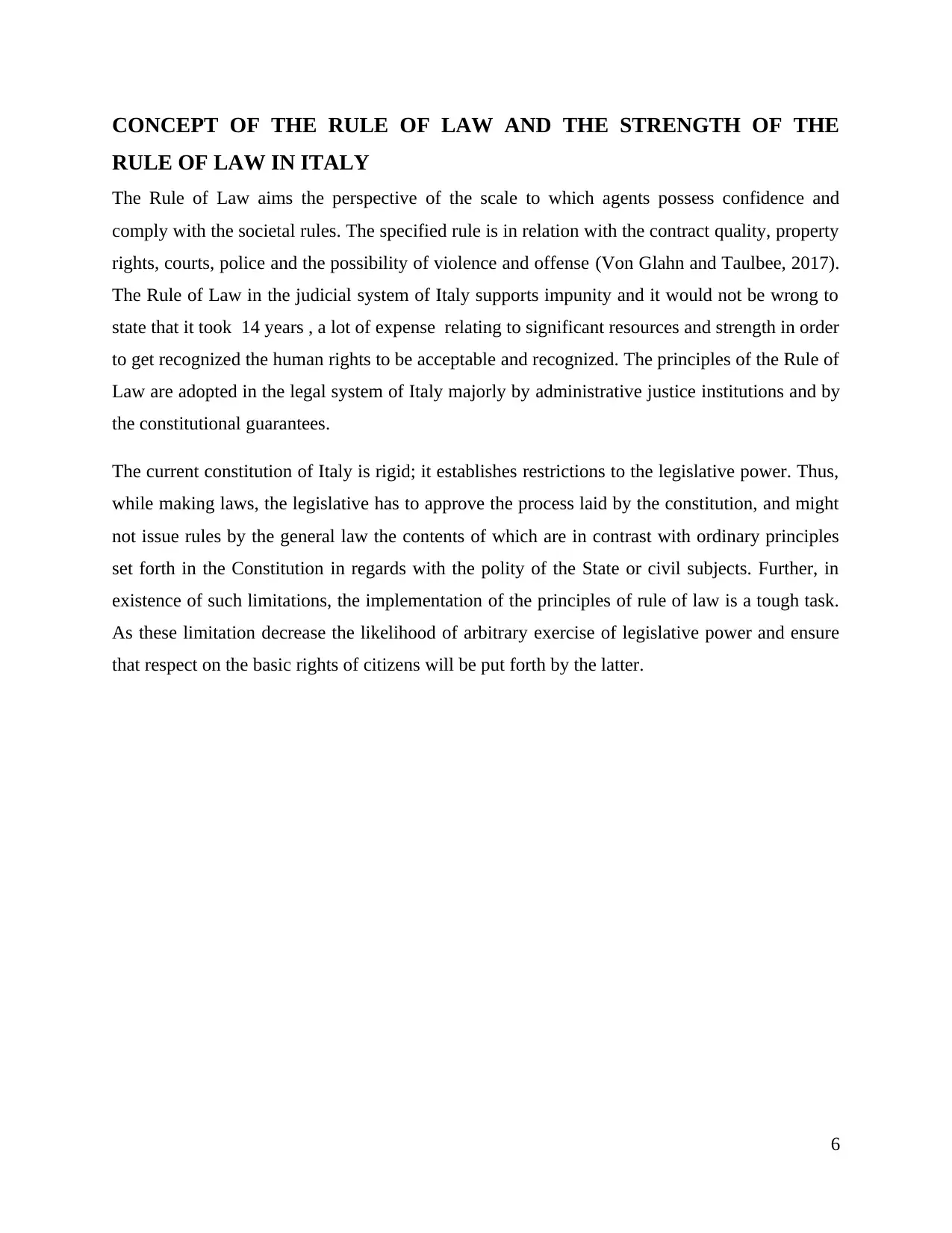
CONCEPT OF THE RULE OF LAW AND THE STRENGTH OF THE
RULE OF LAW IN ITALY
The Rule of Law aims the perspective of the scale to which agents possess confidence and
comply with the societal rules. The specified rule is in relation with the contract quality, property
rights, courts, police and the possibility of violence and offense (Von Glahn and Taulbee, 2017).
The Rule of Law in the judicial system of Italy supports impunity and it would not be wrong to
state that it took 14 years , a lot of expense relating to significant resources and strength in order
to get recognized the human rights to be acceptable and recognized. The principles of the Rule of
Law are adopted in the legal system of Italy majorly by administrative justice institutions and by
the constitutional guarantees.
The current constitution of Italy is rigid; it establishes restrictions to the legislative power. Thus,
while making laws, the legislative has to approve the process laid by the constitution, and might
not issue rules by the general law the contents of which are in contrast with ordinary principles
set forth in the Constitution in regards with the polity of the State or civil subjects. Further, in
existence of such limitations, the implementation of the principles of rule of law is a tough task.
As these limitation decrease the likelihood of arbitrary exercise of legislative power and ensure
that respect on the basic rights of citizens will be put forth by the latter.
6
RULE OF LAW IN ITALY
The Rule of Law aims the perspective of the scale to which agents possess confidence and
comply with the societal rules. The specified rule is in relation with the contract quality, property
rights, courts, police and the possibility of violence and offense (Von Glahn and Taulbee, 2017).
The Rule of Law in the judicial system of Italy supports impunity and it would not be wrong to
state that it took 14 years , a lot of expense relating to significant resources and strength in order
to get recognized the human rights to be acceptable and recognized. The principles of the Rule of
Law are adopted in the legal system of Italy majorly by administrative justice institutions and by
the constitutional guarantees.
The current constitution of Italy is rigid; it establishes restrictions to the legislative power. Thus,
while making laws, the legislative has to approve the process laid by the constitution, and might
not issue rules by the general law the contents of which are in contrast with ordinary principles
set forth in the Constitution in regards with the polity of the State or civil subjects. Further, in
existence of such limitations, the implementation of the principles of rule of law is a tough task.
As these limitation decrease the likelihood of arbitrary exercise of legislative power and ensure
that respect on the basic rights of citizens will be put forth by the latter.
6
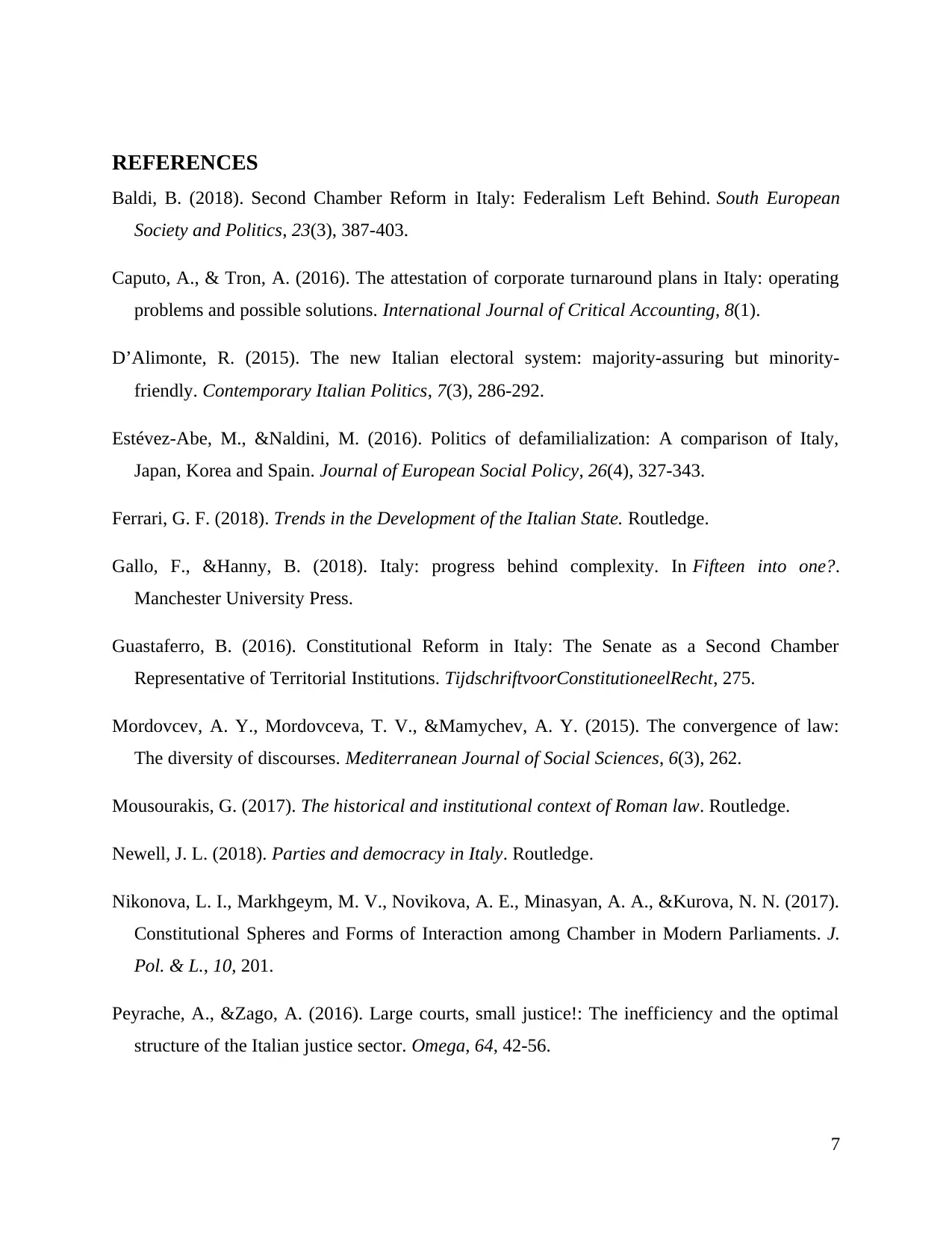
REFERENCES
Baldi, B. (2018). Second Chamber Reform in Italy: Federalism Left Behind. South European
Society and Politics, 23(3), 387-403.
Caputo, A., & Tron, A. (2016). The attestation of corporate turnaround plans in Italy: operating
problems and possible solutions. International Journal of Critical Accounting, 8(1).
D’Alimonte, R. (2015). The new Italian electoral system: majority-assuring but minority-
friendly. Contemporary Italian Politics, 7(3), 286-292.
Estévez-Abe, M., &Naldini, M. (2016). Politics of defamilialization: A comparison of Italy,
Japan, Korea and Spain. Journal of European Social Policy, 26(4), 327-343.
Ferrari, G. F. (2018). Trends in the Development of the Italian State. Routledge.
Gallo, F., &Hanny, B. (2018). Italy: progress behind complexity. In Fifteen into one?.
Manchester University Press.
Guastaferro, B. (2016). Constitutional Reform in Italy: The Senate as a Second Chamber
Representative of Territorial Institutions. TijdschriftvoorConstitutioneelRecht, 275.
Mordovcev, A. Y., Mordovceva, T. V., &Mamychev, A. Y. (2015). The convergence of law:
The diversity of discourses. Mediterranean Journal of Social Sciences, 6(3), 262.
Mousourakis, G. (2017). The historical and institutional context of Roman law. Routledge.
Newell, J. L. (2018). Parties and democracy in Italy. Routledge.
Nikonova, L. I., Markhgeym, M. V., Novikova, A. E., Minasyan, A. A., &Kurova, N. N. (2017).
Constitutional Spheres and Forms of Interaction among Chamber in Modern Parliaments. J.
Pol. & L., 10, 201.
Peyrache, A., &Zago, A. (2016). Large courts, small justice!: The inefficiency and the optimal
structure of the Italian justice sector. Omega, 64, 42-56.
7
Baldi, B. (2018). Second Chamber Reform in Italy: Federalism Left Behind. South European
Society and Politics, 23(3), 387-403.
Caputo, A., & Tron, A. (2016). The attestation of corporate turnaround plans in Italy: operating
problems and possible solutions. International Journal of Critical Accounting, 8(1).
D’Alimonte, R. (2015). The new Italian electoral system: majority-assuring but minority-
friendly. Contemporary Italian Politics, 7(3), 286-292.
Estévez-Abe, M., &Naldini, M. (2016). Politics of defamilialization: A comparison of Italy,
Japan, Korea and Spain. Journal of European Social Policy, 26(4), 327-343.
Ferrari, G. F. (2018). Trends in the Development of the Italian State. Routledge.
Gallo, F., &Hanny, B. (2018). Italy: progress behind complexity. In Fifteen into one?.
Manchester University Press.
Guastaferro, B. (2016). Constitutional Reform in Italy: The Senate as a Second Chamber
Representative of Territorial Institutions. TijdschriftvoorConstitutioneelRecht, 275.
Mordovcev, A. Y., Mordovceva, T. V., &Mamychev, A. Y. (2015). The convergence of law:
The diversity of discourses. Mediterranean Journal of Social Sciences, 6(3), 262.
Mousourakis, G. (2017). The historical and institutional context of Roman law. Routledge.
Newell, J. L. (2018). Parties and democracy in Italy. Routledge.
Nikonova, L. I., Markhgeym, M. V., Novikova, A. E., Minasyan, A. A., &Kurova, N. N. (2017).
Constitutional Spheres and Forms of Interaction among Chamber in Modern Parliaments. J.
Pol. & L., 10, 201.
Peyrache, A., &Zago, A. (2016). Large courts, small justice!: The inefficiency and the optimal
structure of the Italian justice sector. Omega, 64, 42-56.
7
Paraphrase This Document
Need a fresh take? Get an instant paraphrase of this document with our AI Paraphraser
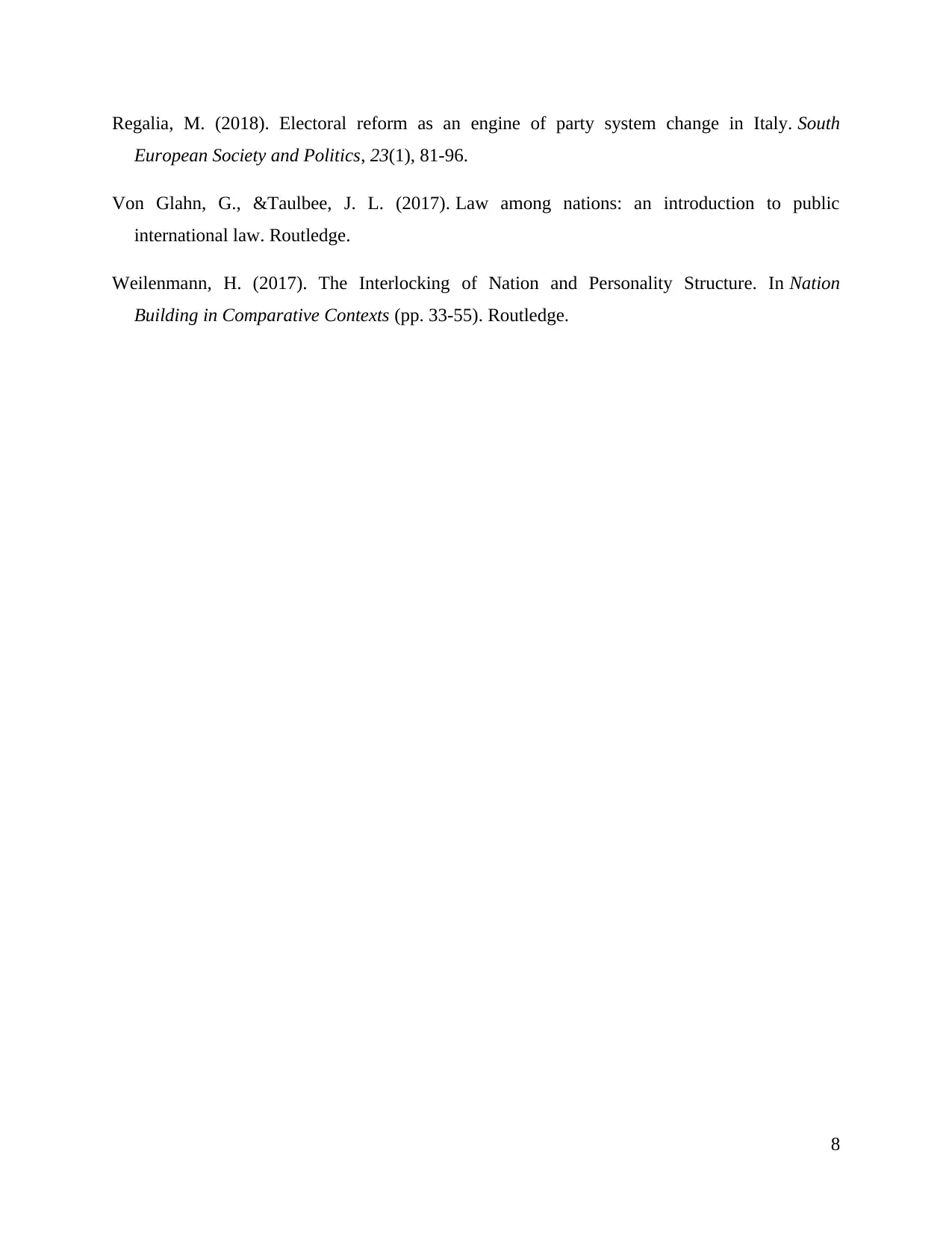
Regalia, M. (2018). Electoral reform as an engine of party system change in Italy. South
European Society and Politics, 23(1), 81-96.
Von Glahn, G., &Taulbee, J. L. (2017). Law among nations: an introduction to public
international law. Routledge.
Weilenmann, H. (2017). The Interlocking of Nation and Personality Structure. In Nation
Building in Comparative Contexts (pp. 33-55). Routledge.
8
European Society and Politics, 23(1), 81-96.
Von Glahn, G., &Taulbee, J. L. (2017). Law among nations: an introduction to public
international law. Routledge.
Weilenmann, H. (2017). The Interlocking of Nation and Personality Structure. In Nation
Building in Comparative Contexts (pp. 33-55). Routledge.
8

9
1 out of 9
Related Documents
Your All-in-One AI-Powered Toolkit for Academic Success.
+13062052269
info@desklib.com
Available 24*7 on WhatsApp / Email
![[object Object]](/_next/static/media/star-bottom.7253800d.svg)
Unlock your academic potential
© 2024 | Zucol Services PVT LTD | All rights reserved.





